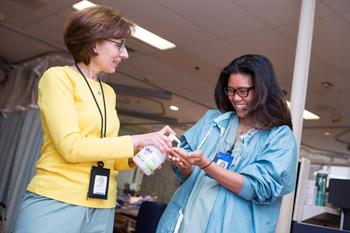Stop, clean your hands! Hand-hygiene rates jump in the ICUs

By Emily Holton

RN Debbie Snatenchuk reminds RN Myra Mendoza to clean her hands before entering the patient environment in the Medical/Surgical ICU. (Photo by Yuri Markarov)
With an impressive burst of collective energy, staff and physicians in all four of St. Michael’s Intensive Care Units boosted their Moment 1 hand-hygiene rates by several percentage points in just one year. “Moment 1” means cleaning hands before contact with the patient or patient environment.
“Improving hand hygiene is usually a long journey,” said Dr. Douglas Sinclair, Executive Vice-President and Chief Medical Officer. “The ICUs also face unique challenges – the open-concept environment makes it difficult to do Moment 1 correctly every time. That’s why the progress our ICUs have made is quite extraordinary. It’s wonderful to see their hard work pay off.”
What sparked the improvements? Each ICU used a different mix of improvement strategies, but two common approaches emerged: peer-to-peer feedback and structured, team discussion.
“We surveyed our staff to see if they were open to peer-to-peer feedback,” said Joanna Parkes, a physiotherapist in the Heart and Vascular Program. “Everyone said the same thing: they have no problem receiving feedback, but weren’t comfortable giving it to peers.”
When the ICU teams discussed these findings, it was an “aha” moment for many staff. Culture has since changed so that peer-to-peer feedback is now common across the ICUs, whether that means stopping a colleague with a friendly reminder in the moment, or revisiting the missed opportunity later on.
Each ICU has also built hand-hygiene discussions into their regular rounds and team meetings. Checklists and prompts invite feedback and discussion about missed opportunities and ideas for improvement.
“We focus our discussions on the numbers and on myth busting,” said Vasuki Parmalingam, clinical nurse educator in the Trauma/Neurosurgery ICU. “Our hand-hygiene performance data is broken down by discipline, which has been key to getting buy-in from our front-line. There were some misconceptions which we were able to solve as an interdisciplinary team.”
“We’ve been focused on hand hygiene for many years in MSICU, what has recently seemed to help was regular, morning, safety huddles,” said Shannon Swift, clinical nurse educator in the Medical/Surgical ICU. “Discussing hand-hygiene challenges along with other pressing safety concerns reinforced the message that Moment 1 is important: we do it because it protects our patients from harm.”
About St. Michael’s Hospital
St. Michael’s Hospital provides compassionate care to all who enter its doors. The hospital also provides outstanding medical education to future health care professionals in more than 29 academic disciplines. Critical care and trauma, heart disease, neurosurgery, diabetes, cancer care, and care of the homeless are among the Hospital’s recognized areas of expertise. Through the Keenan Research Centre and the Li Ka Shing International Healthcare Education Center, which make up the Li Ka Shing Knowledge Institute, research and education at St. Michael’s Hospital are recognized and make an impact around the world. Founded in 1892, the hospital is fully affiliated with the University of Toronto.
